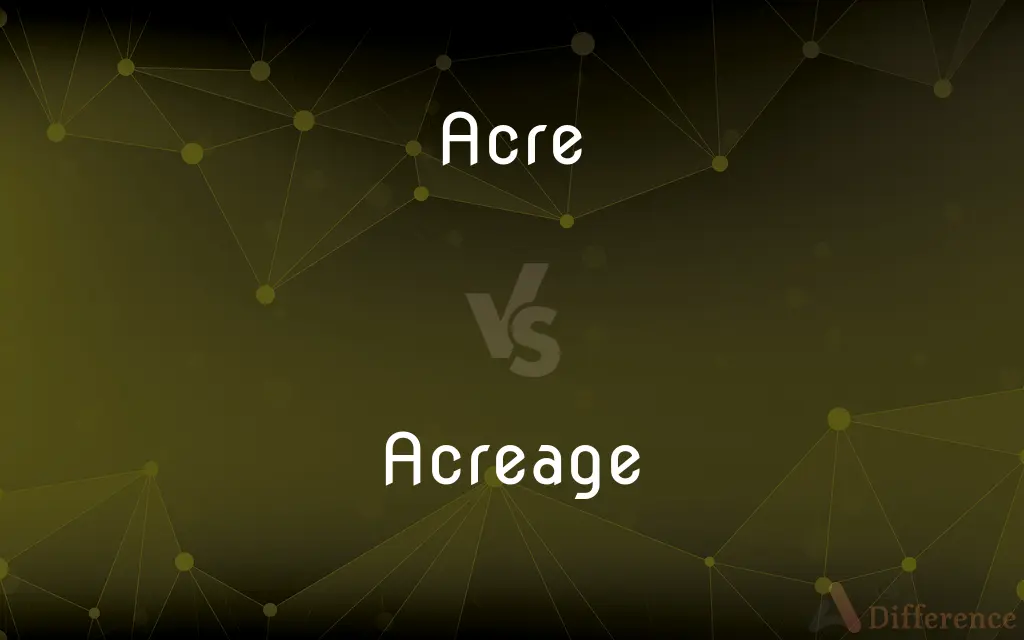Acre vs. Acreage — What's the Difference?
Edited by Tayyaba Rehman — By Maham Liaqat — Updated on March 31, 2024
An acre is a unit of area measurement equal to 43,560 square feet, commonly used in land assessment. Acreage refers to the size of a specific piece of land measured in acres.

Difference Between Acre and Acreage
Table of Contents
ADVERTISEMENT
Key Differences
An acre is a standardized unit of measure used primarily in the United States, the United Kingdom, and some Commonwealth countries for land and real estate. It historically originated from the amount of land that could be plowed by a yoke of oxen in one day. Whereas acreage describes the total number of acres in a particular piece of land, indicating its size. For instance, a plot of land can be described as having 10 acres of acreage.
The use of the term acre allows for a standardized way of understanding and comparing land areas, making it easier for transactions, planning, and management. On the other hand, acreage is a more general term that refers to the size of an area, without specifying its dimensions or shape. It's often used in real estate to describe the size of a property in a more general sense.
While an acre is a specific measurement with a defined square footage, acreage does not imply a specific number. Acreage can refer to any quantity of land measured in acres, ranging from less than one to several thousand. This distinction is important in real estate and land management, where the size of a property can significantly impact its value, usage, and zoning.
Furthermore, the concept of an acre as a unit of measurement allows for precise calculations and comparisons. For example, when planning construction projects or agricultural activities, knowing the exact acreage—the number of acres—of land available is crucial for allocation and utilization.
In documentation and legal descriptions, the term "acre" is used to denote the exact size of a parcel of land, while "acreage" is often seen in listings and discussions, providing a more general understanding of a property's size. This nuance highlights the practical application of both terms in different contexts, with "acre" serving a more technical role and "acreage" a descriptive one.
ADVERTISEMENT
Comparison Chart
Definition
A unit of area equal to 43,560 square feet.
The total size of a piece of land measured in acres.
Usage
Measurement standard for land areas.
Describes the size of land in a general sense.
Specificity
Exact measurement.
Can be any number of acres, not specific.
Application
Used in legal, planning, and land management contexts.
Often used in real estate listings and general property descriptions.
Example
"This plot is 5 acres."
"The property has a large acreage."
Compare with Definitions
Acre
Used in real estate and agriculture.
The farm spans 150 acres of fertile land.
Acreage
Used to describe land expanses.
They were impressed by the vast acreage of the farm.
Acre
A unit for measuring land areas.
He bought a 2-acre parcel for his new home.
Acreage
Refers to the size of a plot of land in acres.
The acreage of the estate makes it ideal for development.
Acre
Equals 43,560 square feet.
The lot's size of one acre perfectly fit their needs.
Acreage
Common in property listings.
Buyers are often looking for homes with substantial acreage.
Acre
Based on the area plowable in one day.
An acre was historically considered a day's work for a yoke of oxen.
Acreage
Indicates land's total area in acres.
The total acreage dedicated to vineyards has increased.
Acre
Common in the US and UK.
Local zoning laws require a minimum of half an acre for residential construction.
Acreage
Can refer to various sizes.
The national park's acreage protects diverse ecosystems.
Acre
The acre is a unit of land area used in the imperial and US customary systems. It is traditionally defined as the area of one chain by one furlong (66 by 660 feet), which is exactly equal to 10 square chains, 1⁄640 of a square mile, or 43,560 square feet, and approximately 4,047 m2, or about 40% of a hectare.
Acreage
Area of land measured in acres.
Acre
A unit of area in the US Customary System, used in land and sea floor measurement and equal to 160 square rods, 4,840 square yards, or 43,560 square feet. See Table at measurement.
Acreage
Size, as measured in acres.
Acre
Acres Property in the form of land; estate.
Acreage
An area of land measured in acres.
Acre
(Archaic) A field or plot of arable land.
Acreage
Acres collectively; as, the acreage of a farm or a country.
Acre
Often acres A wide expanse, as of land or other matter
"acres of textureless carpeting" (Anne Tyler).
Acreage
An area of ground used for some particular purpose (such as building or farming);
He wanted some acreage to build on
Acre
An English unit of land area (symbol: a. or ac.) originally denoting a day's ploughing for a yoke of oxen, now standardized as 4,840 square yards or 4,046.86 square meters.
Acre
An area of 10,240 square yards or 4 quarters.
Acre
Any of various similar units of area in other systems.
Acre
A wide expanse.
I like my new house - there’s acres of space!
Acre
A large quantity.
Acre
(obsolete) A field.
Acre
(obsolete) The acre's breadth by the length, English units of length equal to the statute dimensions of the acre: 22 yds (≈20 m) by 220 yds (≈200 m).
Acre
(obsolete) A duel fought between individual Scots and Englishmen in the borderlands.
Acre
Any field of arable or pasture land.
Acre
A piece of land, containing 160 square rods, or 4,840 square yards, or 43,560 square feet. This is the English statute acre. That of the United States is the same. The Scotch acre was about 1.26 of the English, and the Irish 1.62 of the English.
I like that ancient Saxon phrase, which callsThe burial ground, God's acre.
Acre
A unit of area (4840 square yards) used in English-speaking countries
Acre
A territory of western Brazil bordering on Bolivia and Peru
Acre
A town and port in northwestern Israel in the eastern Mediterranean
Common Curiosities
Can acreage refer to less than one acre?
Yes, acreage can refer to land sizes that are less than one acre, as it broadly describes the size of a property in acres.
How is acreage used in real estate?
Acreage is used to describe the size of a property in terms of acres, often highlighting the expansiveness of the land.
Why is it important to know the acreage of a property?
Knowing the acreage is crucial for understanding the scale of the property, which affects its value, potential use, and zoning regulations.
How do you convert acres to square feet?
To convert acres to square feet, multiply the number of acres by 43,560 (the number of square feet in one acre).
What is the difference between an acre and acreage?
An acre is a specific unit of area measurement, while acreage refers to the total size of land measured in acres.
Is there a standard size for an acre?
Yes, an acre is standardized at 43,560 square feet in measurement.
How does acreage impact property value?
Generally, larger acreages can increase a property's value, especially in rural or undeveloped areas where land is a significant asset.
Can acreage be exact or is it always an estimate?
Acreage can be an exact measurement when calculated professionally, though it is often used in a more general sense in property descriptions.
Do all countries use acres and acreage for land measurement?
No, the use of acres and acreage is more common in the United States, the United Kingdom, and some Commonwealth countries. Other countries use different units like hectares.
What is the historical significance of an acre?
The acre has historical roots as a measure of land area that could be plowed by a yoke of oxen in one day, reflecting its agricultural origins.
Share Your Discovery

Previous Comparison
Sausage vs. Bologna
Next Comparison
Mosquito vs. AntAuthor Spotlight
Written by
Maham LiaqatEdited by
Tayyaba RehmanTayyaba Rehman is a distinguished writer, currently serving as a primary contributor to askdifference.com. As a researcher in semantics and etymology, Tayyaba's passion for the complexity of languages and their distinctions has found a perfect home on the platform. Tayyaba delves into the intricacies of language, distinguishing between commonly confused words and phrases, thereby providing clarity for readers worldwide.














































